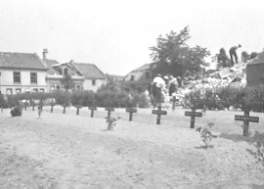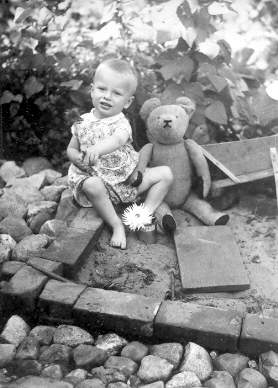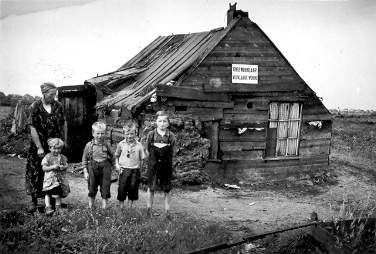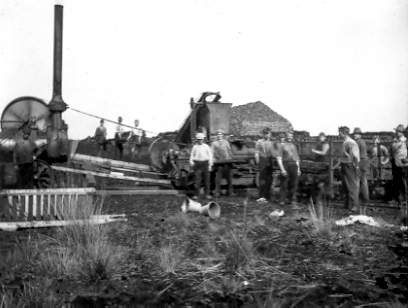

| When I was born on the 25th of June in the year 1942, my parents named me; Robert Hendrik Bruno... That question was quite simple; I didn't have any say in it. The first name is a free choice of my parents, but the other two are the names of both my respective grandfathers. As my father had gotten from his father the surname; "Van der Kamp", I was unable to escape from that either. Oh well, it was a dictatorial time in which a certain Mr. Adolf H. thought he could rule half the world, at least all of Europe. Not everyone agreed to that, of course, but at that time I didn't know too much about that question. Besides that, my father wasn't too happy with my coming; in that very night he found all of his beans frozen! But I always hated big noises and explosions; there were a few bombs falling that night! But I love colder areas! |
| War... not always that far from home as you would like it was!... | ||
 The Hague - 10th of May 1940 |
 Destroyed houses and cars |
 German graves near the airport |
| My uncle, a teacher at Scheveningen but living in The Hague, made these pictures in May 1940... | ||
| My parents lived in Westerhaar, a very little settlement in the eastern part of the Netherlands, about 13 km to the north
of the town of Almelo. My father was a teacher at the local elementary school. In that time we lived there amongst heather, pines and peat cutters. My father was born in
Denekamp; a nice village in Twente, close to the German border and surrounded by beautiful nature. He always longed to come back there, but it never came through. My grandfather
came from Kamperzeedijk, a hamlet on the dike in between Kampen and Genemuiden. He was a fisherman/farmer from origin, but soon he changed his oilskin for the uniform of a policeman
assuring his income much better. I didn't know him as long before I was born, he died. But he always loved the sea and ships, just like my uncle, my father's brother, did. So, I
inherited this nature from my grandfather; not really from my dad, however he liked to sit on the waterside and sometimes he went offshore for sea angling. He disliked my sailing
at the wide sea very much. For me however, there's nothing, that I like more than sailing across God's endless sea! |
My relatives are very international people. Not really from my father's side, as they all were from the Netherlands, for so far I know,
but my mother was born in Duisburg in Germany. Both my parents were born in 1910. My father died in 1984, 74 years old and my mother died in February 2002, 91 y.o. Her father was
from Austrian origin and her mother came from France. For your interest; I also had an uncle from Hungary. When my mother was young, she already met war and violence; in 1914 world war
no. 1 started and the family moved to Vienna. However my grandfather's brother was killed and now he himself became an officer in the combined German - Austrian army. At a certain
moment he disappeared and nobody heard about him for many years. Then, after the war was over, he turned up from an Albanese camp for war prisoners. His health was ruined and he
never got back the vitality he had before the war. I knew him very well, as in 1954 he lived for some time in our home. For me; the world existed in two parts; one mysterious part, very nice and much better, from before the war (no. ll) and another, worse part in which I lived, from after the war.... |
 The elementary school in Westerhaar... |
 ...and the "Dutch Reformed Church"! |
| The family however, had fallen apart and due to the food shortage in the Austrian and German towns, my mother was taken to Pommern - in
that days a part of Germany - on the Baltic coast. She very well remembers that she saw the huge new "Graf Zeppelin" flying for trials; the airship that crashed
at New York later. Nowadays Pommern is part of Poland. Since she was 18 years old, my mother lives in the Netherlands after having been in Belgium for a short time. Her
mother and a sister also came to the Netherlands and my aunt still lives in Nijmegen. Well then; I can't become more international! |
| To gratify your curiosity I enclosed a photograph of myself; it is nothing special, but everybody likes to know the face
behind the story. But there are only a few pictures of my personality; I am always very much successful in escaping from cameras... I like very much to make pictures, but I really
dislike to be pictured myself. So I hardly have one. What question you ask? My marital status? Not really of your business, but I'm not married and I never was, so there is my photo, with me only, without wife and children... But, please, don't think that I became a selfish, shy and pathetic hermit!... Believe it or not, but it's really me... But some time ago, when I was 2 years old. And with my best friend! (I had no other...) |
 |
*****

 The Bruggink family |
Before the second world war and until the sixties thereafter, Westerhaar was a hamlet, not more than a settlement with a few people living there. Many of them were peat cutters and very poor. They were the "have nots" of our high technical world. The hamlet itself was situated on top of a sandhill rising above the moor. The area was covered with heather, pine trees, broom, birches and rowan's. The peat moors were very large and extending far into Germany. You could walk there for miles without meeting anybody. Very often I was wandering there and I most liked the pine trees, as you could hear the song of the wind through the needles and I loved their fine smell! |
These people were allowed to build their houses on top of the moor, but had to
move away when the landlord decided to dig the peat underneath... So, they didn't invest, even if they could have done so. Their
huts were built from old planks and sods. Foeke Visser was living here... |
 The "rich" had a "toilet"!... |
 Well and "lever"pine... |
| However, after the war the government made some new rules and
the landlords were no more permitted to force moving of these people and they had to dig around those huts. Besides that, the new
rules made living in those huts also impossible and the councils had to build new houses to have the peat cutters live in. But it
took a rather long time before the inhabitants were used to this luxury... The old people however, never moved out of their huts;
they stayed there until they died. Therefore I saw the last ones disappearing when I was about ten years old. Working in the peat was only possible during the time from late spring until autumn, when the weather was dry. In the winter they had no job nor income, as the social acts came in the fifties. But also these people had to stay alive and the landlords therefore ran shops too. Thus causing a modern version of slavery, as the folks had to work in summertime to pay for what they got from the landlord during wintertime. Most of these people weren't able to read nor write properly, so they had to trust the landlord, who in many cases wasn't that honest. Many of these folks never saw any money. After the war, Netherlands got a government led by Dr. Willem Drees. He introduced social acts, to make these people more independent from the landlords. |
Life was extremely hard and ruthless and so were these people too... One can imagine that this was
the right breeding ground for the N.S.B. (National Socialism) and to a lesser degree, communism. But it is all gone by the time.
You might see and "admire" these huts and the tools in a museum, but it's me, who saw the reality... All picture in black and white on this page are made by my father from 1932 until 1943. Then, because of the war, the quality of the films were no more reliable and he stopped for a long time.  Locomobile, peat and press. |
 |
 |
| Long, long days of working and a photographer is really something!... | |
| Lunch break! Working days were long... but lunch breaks too! People were that time not in a hurry and they even found time for a laugh. But no way, washing their hands! Somebody wrote a book; "My children do eat peat...". Well, these people really did! |  |
 |
Peat was not only used to be burned for heating; it also was and still is used for soil improvement. The picture shows the dust factory "Trio" on the border of the "Vriezenveensche Wijk" now shortly called; "Veenkanaal". (Peat canal) It really was a dust factory! And I always wondered how people were able to work over there. When cycling along, my eyes always became full of biting dust!.. |
|  Sand trading, big heaps of peat in background |
 The house of the family "Roelofs-behind-the-school"... Westerhaar in the 1940! |
=0=0=0=0=
=0=0=0=0=
| Another, more recent picture of mine. This photo is taken on the balcony of a Russian flat building in Novosibirsk (Siberia). I was there in 1992 on invitation of a Russian guy, who was in the Netherlands at that time. The black-haired lady is his mother, while the other one is a friend of her. There is a more recent picture as you can see on the left side at the bottom. That picture is from October 2000. |  |
[
Sign my Guestbook] - [Read my Guestbook
]
[Guestbook by TheGuestBook.com]